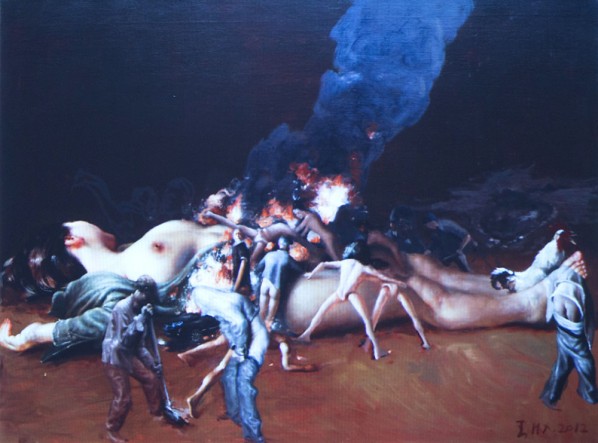
A lecture entitled “Technology is the Premise to Revive Painting” was held at the Red Chair Lecture Hall in CAFA at 18:30, October 10, 2013. Speaker was Prof. Wang Huaxiang from CAFA, Director of the Third Studio of the Department of Printmaking.
At the beginning, Prof. Wang put forward the core concept of “Technology is the premise to revive painting”. Thereafter, he presented in a random and easy way in introducing his ideas on art and artists, technology and painting. His lecture was divided into three parts.
In the first section, Wang expressed his views on professional artists and artistic standards. Wang believed that a true artist had to work alone, isolated, the external interference would affect his/her inner observation in working. At the same time, an artist is an interwoven contradiction of happiness and pain. Happiness for artists is when they own the freedom and independence, which is desired by the inner hearts of humans. Seen from the context of historical development, the developing history of the human is a history for people to search for freedom and human rights, the special professional connotation of artists announced the independence and freedom of this group when it appeared. While the pain was diverted from the survival perspective, artists also belong to labourers, producers, whose producing process is limited by the environment. They produced artworks which had to obey a certain artistic standard and are entitled “elegant” or “vulgar” by the audience. However, it was very difficult to evaluate artworks from the perspective of art standards, because different groups or times had different ideas on art, therefore, there was not an everlasting and uniform artistic standard. In a particular period, it might appear a so-called standard on the basis of pleasing the masses. Like a flock of sheep following the “l(fā)eader”, people used to follow the pace of the so-called “elect”, but actually it might be the most secular of standards set by the upper class. Great artists should have a rebellious spirit, to search for their art outlets. The majority of masters of art history left from their colleagues, nation, and even more their ideas so as to exist far away from the inertia and history. Wang said the young could worship authority, but the older people should dare to challenge authority, and learn to discover the refined section of authority.

In addition, Wang emphasized that thinking was very important. When a thinking and attitude represented a group of people, an age and even an era, it had tremendous power, far better than money, power and materials.
In art appreciation, Wang talked about his idea, only training the skills not just the large number of readings could give artists eyes of discovery. Not only works but also texts were used to convey the inner heart to the outside world, for artists to explain their own creative ideas. In addition, some artists desperately keep up with camera, demanding the authenticity on the surface only led to the decline of sensory aspects and their intelligence. Realistic was not replication, even if mechanical technique was delicate, it was no comparison to the creativity of humans.
In the second section he mainly talked about the relationship between technology and painting. Wang had published a book entitled “Following the Wrong”, which featured his popular views, the main argument was the rebellion towards technology, academy, as well as standards. But after 20 years, Wang has become a staunch supporter of traditional art, which has experienced a complex process.
In 1984, together with his classmates he organized an exhibition of expressionism, but the response was cool, making him feel lost, then he began to devote himself to looking for a new creative direction. After reading a lot of pictures, he had a keen interest in Renaissance paintings, starting to research shape through sketching. When he graduated from CAFA, he created a magnificent, tough realistic artwork of print – “Guizhou People”. After that, he abandoned realism, creating printmaking in a transition period, creating works “Close”, etc. After that, he began to try a creation of oil painting, with a combination of Renaissance paintings and fashion figures, creating pop art of juxtaposition. In the mid 1990s, Wang was in cooperation with Hanhai Auction House, planning the 1999 Spring Hanhai Paintings Auction. Later, Wang went to France, during this period, he was keen on foreign modern art. After that he was engaged in art education, establishing a school Enclave Art Center in 2000. In the process of teaching practice, Wang found that in giving up the application of realistic skills, the creation would be subject to many limitations, therefore, he returned to the realistic, sticking to it from then on.

In the third section, Wang described parts of recent works in the studio as well as his recent individual creations. In the process of introducing his works, he also mentioned a lot of practical experiences in the creation of painting. For example, colors and shapes were embedded in a subtle, precise sense in the creation, and treated painting as creation, the creative happiness would be lost; painting should combine social events and time; creation of paintings was a constantly changing exploration process, painting again and again, good creation was hidden in a changing screen and so on.
Wang Huaxiang eventually concluded: Good art did not need to compete with others, instead, goes into the real world of art.
Journalist: Zhang Gaoshan, Photo: Hu Zhiheng/CAFA ART INFO
Translated by Chen Peihua and edited by Sue/CAFA ART INFO




























